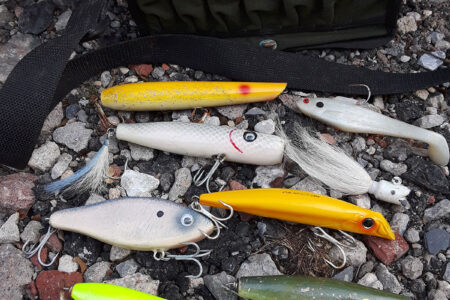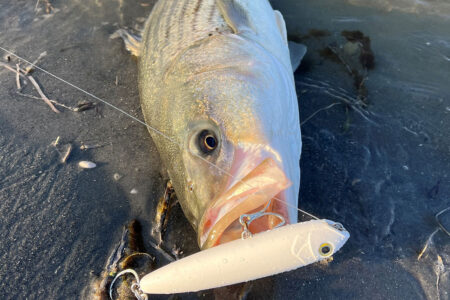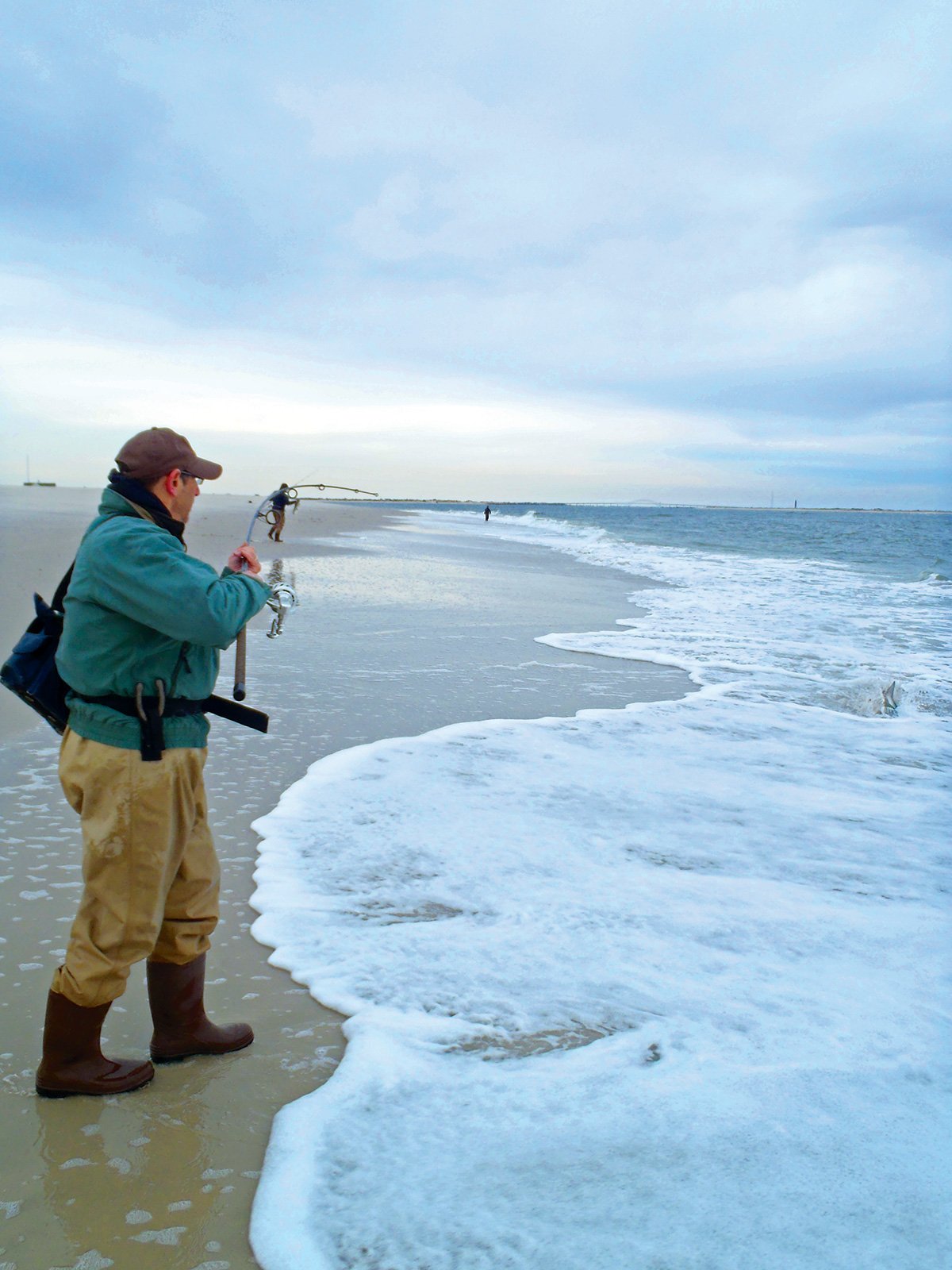
Many surf rats start the season probing Little Neck Bay for school stripers as early as late March, but the first reports of big blues in May usually finds many north shore harbor anglers scurrying for the South Shore inlets. There are no absolutes in fishing, and that holds true for big blues in spring. How many fish, how much bait, and weather conditions, are all nebulous factors that even computers can’t get a firm fix on. However, whether the run lasts one week or six weeks, whether the blues average 10 to 15 pounds or 8 to 12, we have no influence on these matters. It’s Nature’s kaleidoscope, and the best we can do is try to figure out a pattern as the colors and designs change. Our job is to be prepared and take advantage of whatever natural forces conspire to create local patterns.
In that regard, I try to be prepared for the coming run, although I see signs that others are last minute preppers. My bluefish bag is pre-filled with the bluefish friendly plugs, bucktails, and tins, and all hooks have been sharpened to a fine point. There is not only a fresh leader on my rod, there are also six to 10 new ones in a storage space in my bag. Similarly, any reels that needed service were cleaned, greased, and bad parts replaced.
Where
There are no secret early spring bluefish spots. They swarm towards shore after a late April spawn at the edge of the Gulf Stream, and push bait schools as they go. Most of this bait is headed for the inlets for several reasons. First, some species such as adult mullet seek out quiet spawning spots in the bays, while adult bunker seek spots in the bays where they can spawn near the surface during the full-moon period as water temperatures warm. There are also small sand eels in the bays and inlets, and these attract squid shoals from the ocean. In addition to these basic food groups there may also be shad and butterfish. All of these prey items enter the inlets and then flush back and forth with the tides seeking their own best zones for feeding and spawning. Thus, early blues concentrate in and near south shore inlets, where food is usually most abundant. They are, after all, hungry after the spawn and although many may arrive lean and mean, heavy feeding often puts depth and width on their bodies quickly.
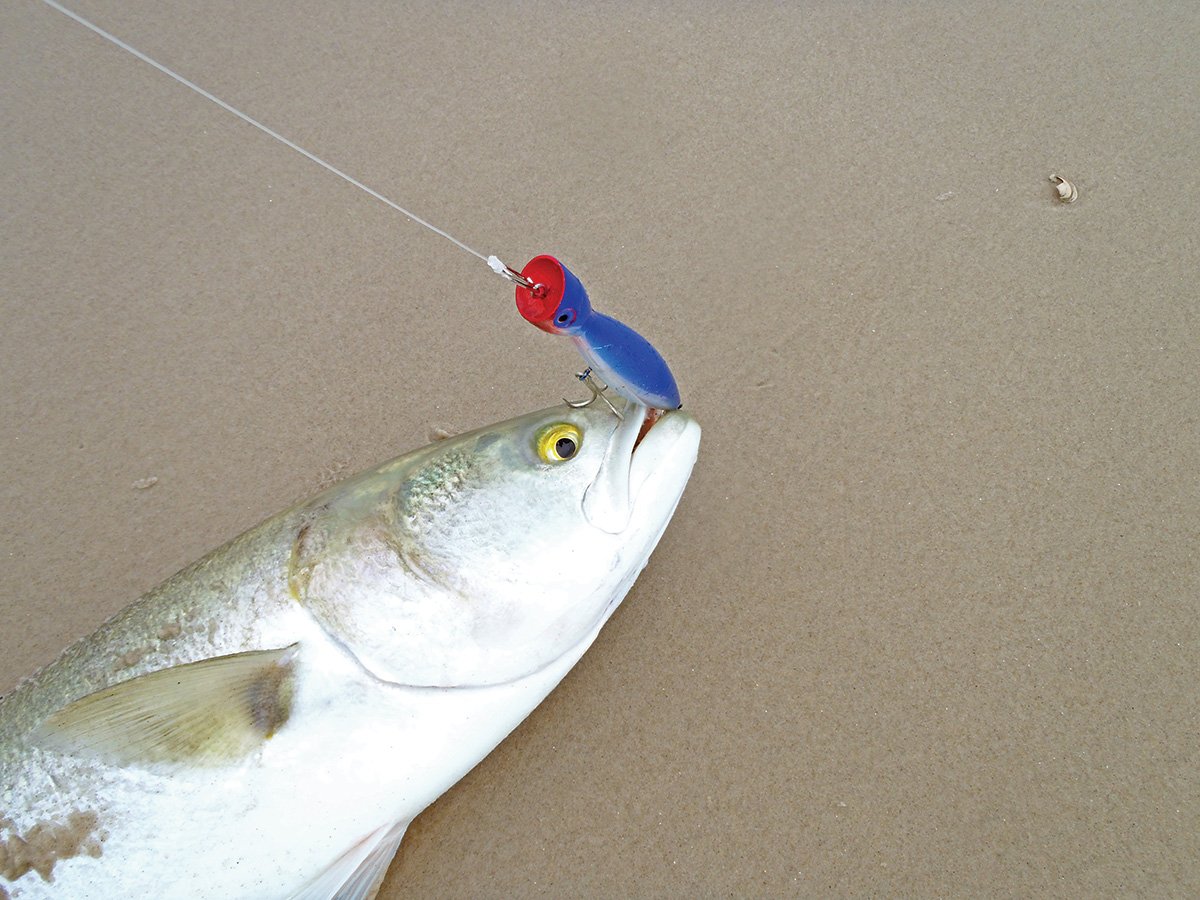
Although inlets are prime locations, I never neglect the open ocean beaches because if blues find large bunker schools on their way to the inlets, they may push them shoreward, and sometimes the bunker end up pinned against the ocean beaches just a short distance from the mouths of the inlets. I’ve enjoyed more than a few days along the front beaches not far from the inlets catching monster blues gorging on bunker. Problem is, that blitz isn’t likely to occur two days in arrow. For consistency, stick with the inlets: the one closest to where you live. There is simply no need to use gasoline to find the fish, because, as I indicated, they enter all inlets at about the same time. However, if you insist on catching the biggest blues, it may pay to snoop around to find them. Invading schools may not be the same size at all entry points. For example, last year I fished both Fire Island and Moriches Inlet areas. Although this observation is merely anecdotal, I found there were more fish around Moriches, and I caught them on every trip, but the fish around Fire Island Inlet tended to be a few pounds heavier, but the action varied widely from day to day.
Tackle
As popular as light tackle fishing has become in so many venues, my sense is this is not the time, the place, or the species for it. Although the inlet mouths are often rather calm, it is spring and there are many days when cold and wind can interfere with light tackle presentations. Then too, the best lures are rather large because the bait and blues tend to be rather large. If one of these springs the run is dominated by 2- to 5-pound blues, then light tackle might be the best approach. But, I count on big blues showing up in May.
I use two outfits for this fishing. An 11-foot medium power graphite rod equipped with either a VS 275 or 250, each spooled with 30-pound test Sufix Performance Braid. I also use a 9-foot medium powered rod and match that to a VS 200, spooled with 20-pound test braid. If you are able to tie quality knots, heavier line simply doesn’t give you an advantage. Blues can chew through 50-pound test braid just as easily as 20-pound test. Twenty- and 30-pound test gives me great casting distance and more precise casts, and I find those to be more important than resistance to teeth through heavier line.
Simple is Best
Let’s face it, May blues are easy to catch if they’re around. They are ravenous and their only reason to be cruising in the inlets is to find food and eat. So, I keep my lure choices simple. I begin by dismissing color. It’s so much easier to be monochromatic because it limits your choices to style distinctions rather than color. The simplicity reduces hesitancy when selecting a lure. I also don’t tote around a vast variety of lure sizes. I stick with big lures since I’m looking for big fish that are hungry. Besides, I can’t imagine a blue turning down a 2-3/8-ounce popper, insisting instead on a 3-ounce version. Super Strike Little Neck Poppers of 2-3/8 ounces cast great, swim when not popped, and blues love them. I apply the same philosophy to pencil poppers. Forget my beloved 1-ounce Cotton Cordell Pencil Poppers in this spring venue, because castability isn’t great and a wind in your face will push the lure back toward the beach half-way into the cast. Again, 2-3/8-ounce Gibbs pencil poppers work great. Although I prefer sub-surface lures most of the time because I believe hook-ups are more secure and the fish are easier to remove, if I see surface breaks, swirls, or groups of birds picking bait off the surface I switch to poppers and pencils poppers.
Tins
I carry some tins, too. I like West End Tackle Charlie Graves style metal lures. J-5 through 8, D-5, and WS styles are my favorites. Although other tins also catch fish, I find these West End Tackle lures offer consistent action, cast far, and are durable against chopper teeth. For sure, if the blues are cavorting well off the beach, these tins will usually reach them. However, most of the time blues are only a short cast from the shore making other lures, such as bucktails, practical.
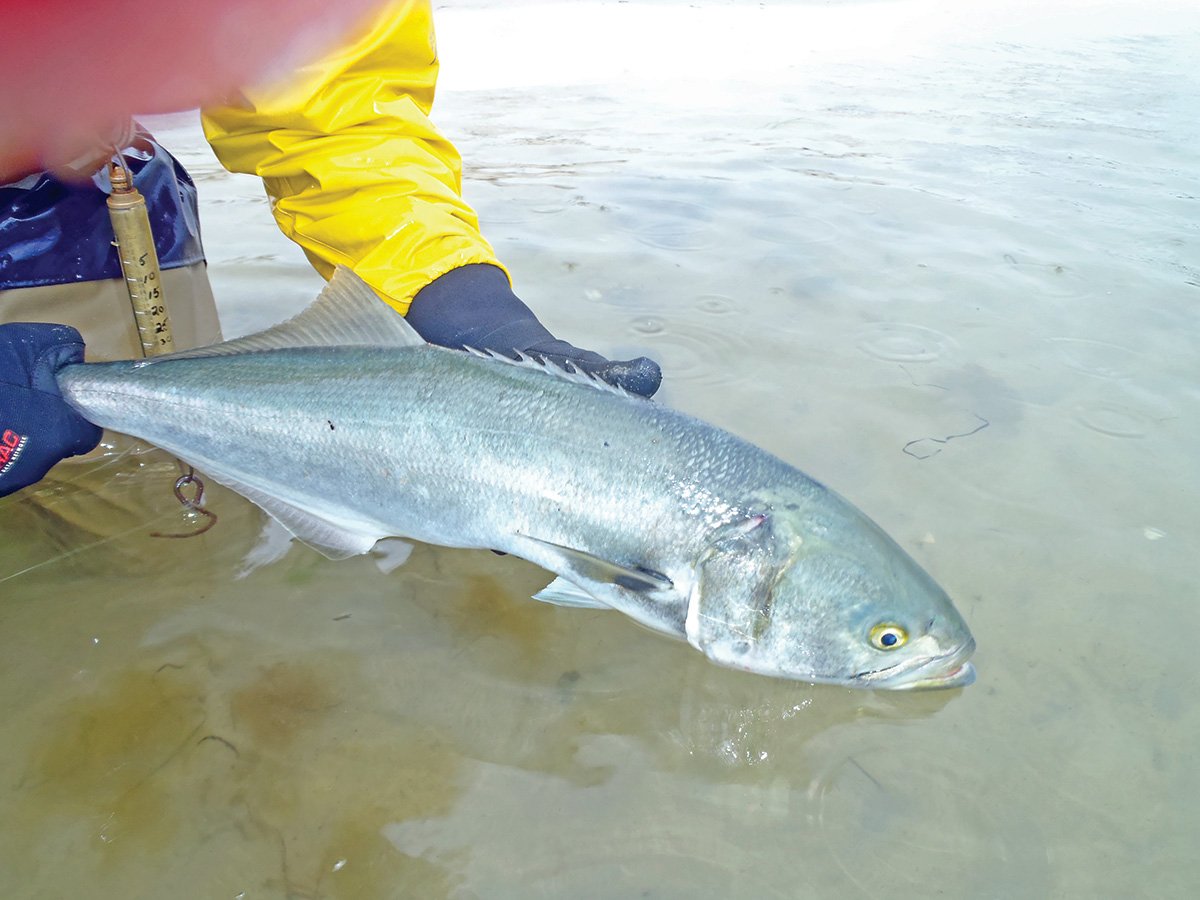
Although I disdain the use of bucktails on small blues, I’ll not hesitate to use them to catch big blues. I use white bucktails with red and white pork rind strips if you have some, or Fat Cow Strips that work equally well. If my color choice is simple, so are my size selections. Generally speaking, the water at the mouths of the inlets will have some depth, so I leave the light bucktails at home. Typically, I divide my bucktail array into three groups of three each: 1-, 1-1/2-, and 2-ounce versions have always covered my needs. Work these bucktails within a foot or so of the bottom because blues commonly cruise at that depth until they find a school of bait.
Should I decide to fish at night I add a bottle plug, darter, SP Minnow, 7-inch Bomber, and maybe a medium metal-lip swimmer for calm water. Lures used in daylight may be retrieved more quickly than those at night because the lack of sunlight means they can’t spot food until they are close and thus attack more deliberately. Then too, water temps in early May are quite cold and the fish somewhat sluggish, so slower retrieves help the fish find and tract the lures. In early May at night, without sunlight to warm the shallows, blues may not bite at all, but by the middle of the month anglers enjoy both day and night bites. Also, if night fishing is your preferred time to hit the beach, late May provides the potential for some nice striped bass because some larger fish from the Chesapeake generally arrive about Memorial Day while Hudson stripers spread out along both shores after the spawn.
Tides
Although I’ve caught early blues on both incoming and outgoing tides, I’ve found that in early May, afternoon outgoing tides produce best because water warms in the shallow bays during the flood tide, and then flows out through the inlets. This ebb flow conspires to improve fishing because slightly warmer water attracts bait and energizes the blues.
Typically, my tidal preference reverses in late May, particularly if weeds become a problem. In recent years, sheets of green sea lettuce and brown stringy masses of slip-gut have made fishing on the ebb frustrating. The flood tide brings cleaner ocean water into the inlets that commonly sweeps the weed into the bays, and although the blues may not necessarily prefer the flood tide, lure presentations are a lot better without weeds.
Each spring I try to be the first to get into some of the newly arrived big blues, but my quest has sometimes been frustrated because although I have arrived, the fish have not. But I don’t mind, because I know although my trip was in vain that day, next time will be different. It’s the nature of anglers to be optimistic. If we weren’t optimists perhaps we’d never go fishing because there are never guarantees; just hope.


